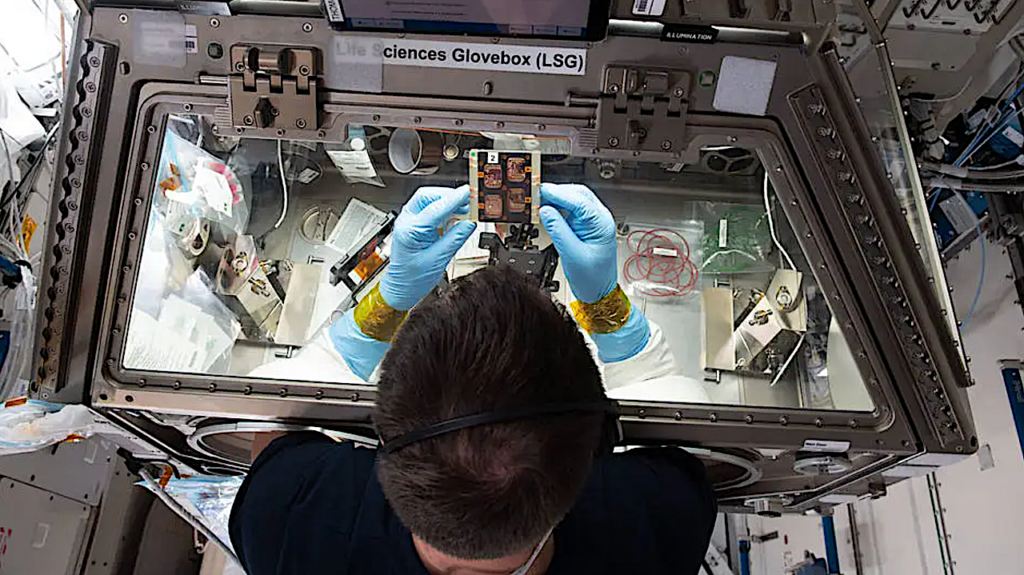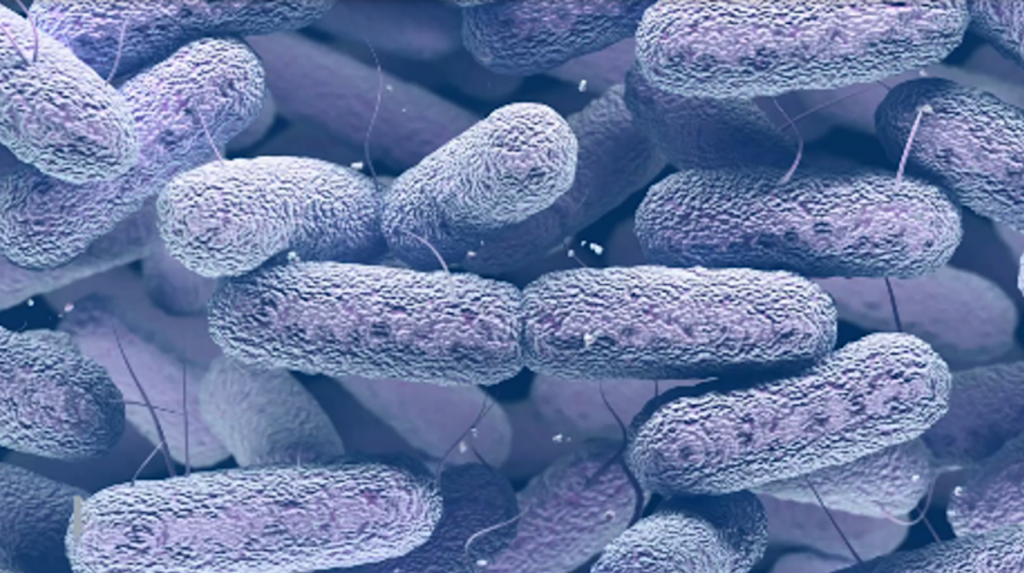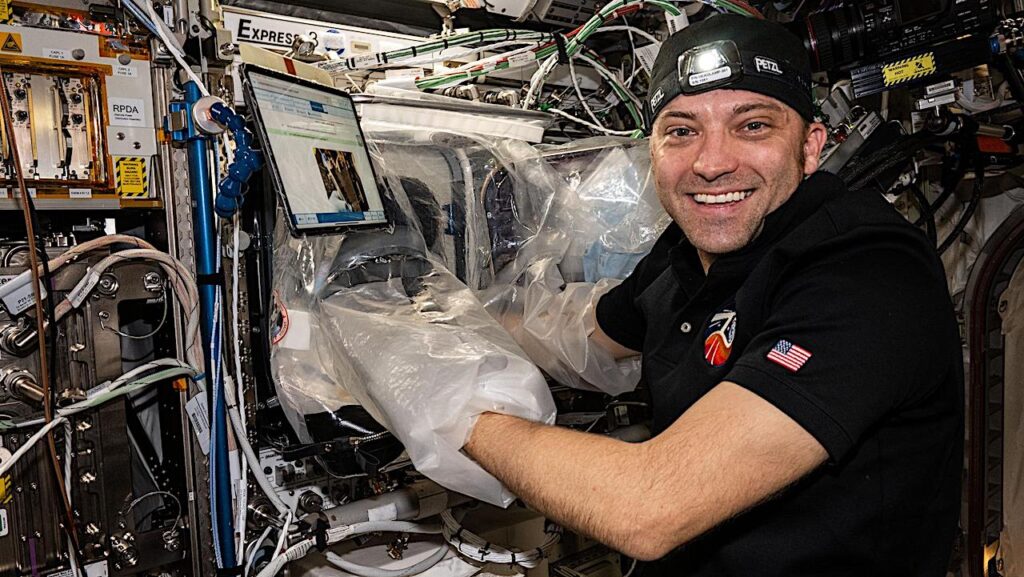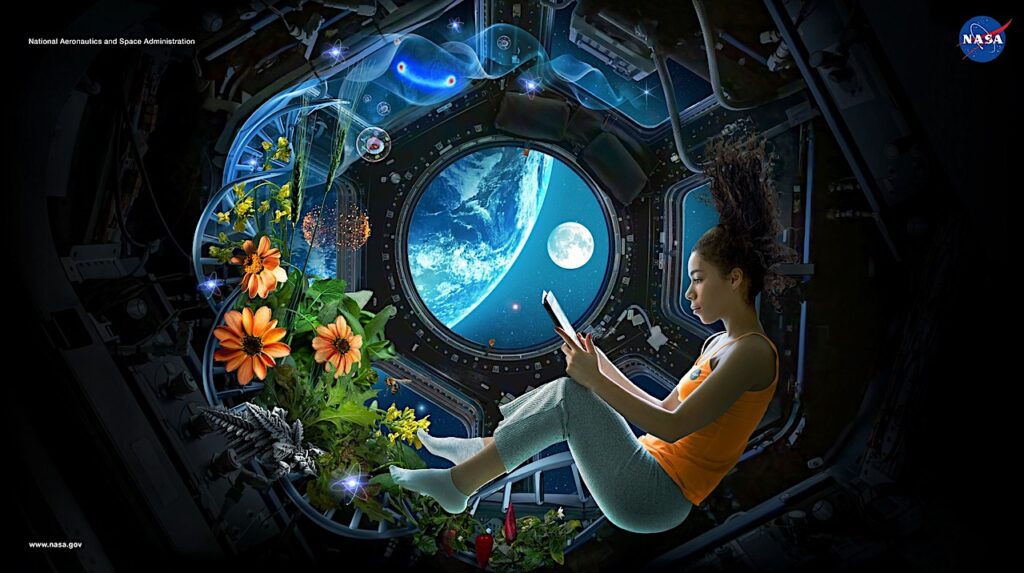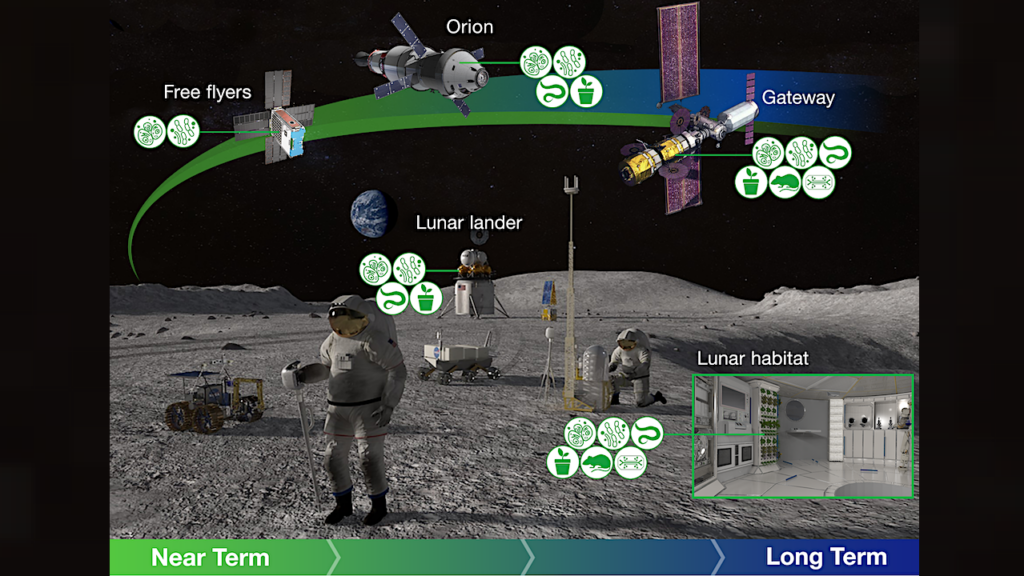NASA Spaceline Current Awareness List #1,087 16 February 2024 (Space Life Science Research Results)

Space Biology — NASA
Papers deriving from NASA support:
- Diao X, Haveman N, Califar B, Dong X, Prentice B, Paul A-L, Ferl RJ.Spaceflight impacts xyloglucan oligosaccharide abundance in Arabidopsis thaliana root cell walls.Life Sci Space Res. 2024 Feb 16. Online ahead of print.PI: A-L. PaulNote: ISS results.
Journal Impact Factor: 2.5
Funding: “Funding was partially provided by NASA Biological and Physical Science (BPS) grant NNX14AT24G to A-L.P and R.J.F., and by a contribution from Eli Lilly and Company to B.M.P. …” - Sarma MS, Shelhamer M.The human biology of spaceflight.American Journal of Human Biology. 2024 Feb 9;e24048. Online ahead of print.PI: M.S. SarmaNote: From the abstract: “Here, we show how the use of evolution-informed frameworks (i.e., models of life history theory to organize the adaptive pressures of spaceflight and biocultural perspectives) coupled with the use of mixed-methodological toolkits can shape models that better encompass the scope of biobehavioral human adjustment to long-duration space travel and extra-terrestrial habitation.”
Journal Impact Factor: 2.9
Funding: “Mallika S. Sarma is supported by the Translational Institute for Space Health through the National Aeronautics and Space Administration Cooperative Agreement NNX16AO69A and the National Institute on Deafness and Other Communication Disorders of the National Institute of Health under Award Number 5T32DC000023-33.” - Soares B, Ong J, Osteicoechea D, Kadipasaoglu CM, Waisberg E, Sarker P, Zaman N, Tavakkoli A, Vizzeri G, Lee AG.A potential compensatory mechanism for spaceflight associated neuro-ocular changes from microgravity: Current understanding and future directions.Eye (Lond). 2024 Feb 8.PI: A. TavakkoliNote: This article is an editorial.
Journal Impact Factor: 3.9
Funding: “NASA Grant [80NSSC20K183]: A Non-intrusive Ocular Monitoring Framework to Model Ocular Structure and Functional Changes due to Long-term Spaceflight.” - Ong J, Waisberg E, Masalkhi M, Suh A, Kamran SA, Paladugu P, Sarker P, Zaman N, Tavakkoli A, Lee AG.“Spaceflight-to-Eye Clinic”: Terrestrial advances in ophthalmic healthcare delivery from space-based innovations.Life Sci Space Res. 2024 Feb 13. Review. Online ahead of print.PI: A. TavakkoliJournal Impact Factor: 2.5
Funding: “NASA Grant [80NSSC20K183]: A Non-intrusive Ocular Monitoring Framework to Model Ocular Structure and Functional Changes due to Long-term Spaceflight.” - Wood JM, Urbaniak C, Parker C, Singh NK, Wong S, Arumugam A, Skorupa DJ, Hemmah A, Laaguiby P, Karouia F, Peyton BM, Tighe S, Venkateswaran K.Assessing microbial diversity in Yellowstone National Park hot springs using a field deployable automated nucleic acid extraction system.Front Ecol Evol. 2024 Feb 9;12:1306008.PI: K. VenkateswaranNote: This article is part of Research Topic “Exploring the Unseen World: Advancements in Understanding Environmental Microorganisms” (https://www.frontiersin.org/research-topics/58347/exploring-the-unseen-world-advancements-in-understanding-environmental-microorganisms/overview). This article may be obtained online without charge.
Journal Impact Factor: 3.0
Funding: “The author(s) declare financial support was received for the research, authorship, and/or publication of this article. This research was supported by the TRISH through Cooperative Agreement NNX16AO69A awarded to KV. The W. M. Keck Foundation provided support for DJS and BMP. The NASA postdoctoral fellowship supported part of JW, CP, and CU time. Preliminary work of this research was supported by a NASA SBIR Contract (NNX17CP21P) awarded to SW.”
Other papers of interest:
- Campisi M, Cannella L, Pavanello S.Cosmic chronometers: Is spaceflight a catalyst for biological ageing?Ageing Res Rev. 2024 Feb 10:102227. Review. Online ahead of print.Note: From the article: “Astronauts returning from space missions often exhibit health issues mirroring age-related conditions, suggesting spaceflight as a potential driver of biological ageing and age-related diseases. To unravel the underlying mechanisms of these conditions, this comprehensive review explores the impact of the space ‘exposome’ on the twelve hallmarks of ageing. Through a meticulous analysis encompassing both space environments and terrestrial analogs, we aim to decipher how different conditions influence ageing hallmarks. Utilizing PubMed, we identified 189 studies and 60 meet screening criteria.”
- Tomsia M, Cieśla J, Śmieszek J, Florek S, Macionga A, Michalczyk K, Stygar D.Long-term space missions’ effects on the human organism: What we do know and what requires further research.Front Physiol. 2024 Feb 12;15:1284644. Review.Note: This article may be obtained online without charge.
- Morgan MF, Diab J, Gilliham M, Mortimer JC.Green horizons: How plant synthetic biology can enable space exploration and drive on Earth sustainability.Curr Opin Biotechnol. 2024 Apr;86:103069. Review.
- Molaro JL, Kapusta A, Wells-Jensen S, Voelker A, Bahram S, Bailey T, Bolles D, Cooper MK, Fair C, Fauerbach M, Gethard L, Gifford SE, Greenhalgh J, Ingram E, Jha S, Kushalnagar R, Link AJ, Mardon AA, Mathur G, Minkara M, Modesta V, O’Brien CAL, Onwuta Z, Rosenstein S, Shear E, Varia S, Varia A, Viirre ES, Whitesides G, Williamson BR, Zucker HR.AstroAccess: Testing accessibility accommodations for disabled and mixed-ability crews operating in space-like environments.Acta Astronaut. 2024 Feb 10. Online ahead of print.
- Arzt M, Mozneb M, Escopete S, Moses J, Sharma A.The benefits of stem cell biology and tissue engineering in low-Earth orbit.Stem Cells Dev. 2024 Feb 7. Online ahead of print.
- Davis T, Tabury K, Zhu S, Angeloni D, Baatout S, Benchoua A, Bereiter-Hahn J, Bottai D, Buchheim JI, Calvaruso M, Carnero-Diaz E, Castiglioni S, Cavalieri D, Ceccarelli G, Choukér A, Cialdai F, Ciofani G, Coppola G, Cusella G, Degl’Innocenti A, Desaphy JF, Frippiat JP, Gelinsky M, Genchi G, Grano M, Grimm D, Guignandon A, Hahn C, Hatton J, Herranz R, Hellweg CE, Iorio CS, Karapantsios T, van Loon J, Lulli M, Maier J, Malda J, Mamaca E, Morbidelli L, van Ombergen A, Osterman A, Ovsianikov A, Pampaloni F, Pavezlorie E, Pereda-Campos V, Przybyla C, Puhl C, Rettberg P, Rizzo AM, Robson-Brown K, Rossi L, Russo G, Salvetti A, Santucci D, Sperl M, Tavella S, Thielemann C, Willaert R, Szewczyk N, Monici M.How are cell and tissue structure and function influenced by gravity and what are the gravity perception mechanisms?npj Microgravity. 2024 Feb 10;10(1):16.Note: This article may be obtained online without charge.
- Lecoq PE, Dupuis C, Mousset X, Benoit-Gonnin X, Peyrin JM, Aider JL.Influence of microgravity on spontaneous calcium activity of primary hippocampal neurons grown in microfluidic chips.npj Microgravity. 2024 Feb 6;10(1):15.Note: From the abstract: “The influence of variations of gravity, either hypergravity or microgravity, on the brain of astronauts is a major concern for long journeys in space, to the Moon or to Mars, or simply long-duration missions on the ISS (International Space Station). Monitoring brain activity, before and after ISS missions already demonstrated important and long-term effects on the brains of astronauts. In this study, we focus on the influence of gravity variations at the cellular level on primary hippocampal neurons. A dedicated setup has been designed and built to perform live calcium imaging during parabolic flights. During a CNES (Centre National d’Etudes Spatiales) parabolic flight campaign, we were able to observe and monitor the calcium activity of 2D networks of neurons inside microfluidic devices during gravity changes over different parabolas. Our preliminary results clearly indicate a modification of the calcium activity associated to variations of gravity.”
- Mitrokhin VM, Kamkina OV, Kamkin AG, Rodina AS, Zolotareva AD, Zolotarev VI, Kazansky VE, Gorbacheva LR, Bilichenko AS, Shileiko SA, Mladenov MI.Simulated microgravity and hypergravity affect the expression level of soluble guanylate cyclase, adenylate cyclase, and phosphodiesterase genesin rat ventricular cardiomyocytes.Bull Exp Biol Med. 2024 Feb 12.Note: From the abstract: “Ion channels activity is regulated through soluble guanylate cyclase (sGC) and adenylate cyclase (AC) pathways, while phosphodiesterases (PDE) control the intracellular levels of cAMP and cGMP. Here, we applied RNA transcriptome sequencing to study changes in the gene expression of the sGC, AC, and PDE isoforms in isolated rat ventricular cardiomyocytes under conditions of microgravity and hypergravity.”
- Ye Y, Xie W, Ma Z, Wang X, Wen Y, Li X, Qi H, Wu H, An J, Jiang Y, Lu X, Chen G, Hu S, Blaber EA, Chen X, Chang L, Zhang W.Conserved mechanisms of self-renewal and pluripotency in mouse and human ESCs regulated by simulated microgravity using a 3D clinostat.Cell Death Discov. 2024 Feb 9;10(1):68.Note: A 3D clinostat was used in this study. This article may be obtained online without charge.
- Bolduc DL, Cary LH, Kiang JG, Kurada L, Kumar VP, Edma SA, Olson MG, Vergara VB, Bistline DD, Reese M, Kenchegowda D, Hood M, Korotcov A, Jaiswal S, Blakely WF.Natural-history characterization of a murine partial-body irradiation model system: Establishment of a multiple-parameter based GI-ARS severity-scoring system.Radiat Res. 2024 Feb 6. Online ahead of print.
- Ohira T, Ino Y, Kawao N, Mizukami Y, Okada K, Matsuo O, Hirano H, Kimura Y, Kaji H.Plasminogen deficiency exacerbates skeletal muscle loss during mechanical unloading in developing mice.J Appl Physiol (1985). 2024 Feb 8. Online ahead of print.Note: Hindlimb unloading study.
- Zhu D, Qiao P, Zhou Q, Sun H, Xin B, Wu B, Tang C.Effect of 15 days -6° head-down bedrest on microbial communities of supragingival plaque in young men.Front Microbiol. 2024 Jan 24;15:1331023.Note: Head-down bedrest study. This article may be obtained online without charge.
- Uchida T, Kohno M, Ito C, Yamano E, Matsuki H, Mizanur RMD, Anayt U, Suzuki M, Ishiguro T, Nikawa T.Inhibitory effect of Kori-tofu protein on denervation-induced atrogene expression in mouse skeletal muscle.J Biol Sci. 2024 Feb 7;38:1-7.Note: This article may be obtained online without charge.
- Gornostaeva AN, Buravkova LB.Immunomodulation sensitivity of innate immunity cells in healthy human subjects during 21-day “dry” immersion.Hum Physiol. 2024 Jan 26;49(7):883-9.
- Kochergin AY, Markin AA, Zhuravleva OA, Vostrikova LV, Zabolotskaya IV, Kuzichkin DS, Zhuravleva TV, Smirnova TA, Vorontsov AL.Influence of 21-day head-down bedrest on the hemostasis system of a healthy human.Hum Physiol. 2024 Jan 26;49(7):815-8.
- Vlasova DD, Sadova AA, Galina VS, Guermanov NS, Rykova MP, Antropova EN, Kutko OV, Shulguina SM, Orlova KD, Shmarov VA, Lysenko EA, Ponomarev SA.Effect of 21-day dry immersion on expression of inborn immunity genes associated with the toll-like receptors of signaling pathways.Hum Physiol. 2024 Jan 26;49(7):807-14.
- Shoshina II, Kotova DA, Zelenskaya IS, Lyapunov SI, Lyapunov IS, Bekreneva MP, Tomilovskaya ES.Contrast sensitivity and ocular microtremor: A model study of gravity effects on visual perception.Hum Physiol. 2024 Jan 26;49(7):800-6.
Astrobiology, space biology,


